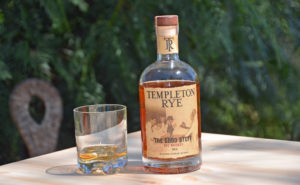American Rye Whiskey: A Primer
By S.D. Peters
It could be the Pennsylvania blood in my veins or a taste for the less popular that made a Rye drinker of me. American Rye whiskey, that is. But really, if I’m going by taste, then it’s the distinctly dry, spicy qualities that drew me to this often overlooked style of American whiskey.
Or, I should say, once overlooked.

(Credit: Richard Thomas)
If my local liquor stores, three nearby distillers, and lashings of online articles going back to the mid-Noughties are bellwethers, then American Rye is back. Fashionable Rye enthusiasts might wince upon hearing their whiskey is in resurgence (aficionados revel in being “one of a few”), although the stock at many a local watering hole suggests the resurgence is not exactly popular. More like boutique… which should actually please the devotees.
Some of us aren’t quite so cultish about it. The dearth of American Rye behind the bar belies the variety that’s available these days, and we’d love to see more whiskey drinkers enjoying it. We’d like to walk into any bar, ask for an American Rye, and hear the bartender reply “Sure, what’s your brand?” If that’s already happening in your bar, consider yourself lucky, and try a few. (Also, let me know the name of your bar and the town it’s in!)
American v. Canadian Rye
I’m qualifying American Rye whiskey because there’s also Canadian Rye whiskey. The basic difference, under U.S. law, is that American Rye must have at least 51% rye grain in the mashbill (most American Ryes have more). There is no complimentary Canadian law for Canadian-distilled Rye whiskey, just historical evidence: since Canadian whiskeys were distilled mostly from rye, it’s OK to call them “Rye” whiskeys.
If you want genuine Rye whiskey, American Rye is for you. In addition to the 51% minimum rye mashbill (corn and barley malt typically round out the bill), the U.S. Code of Federal Regulations (27 C.F.R. 5) also specifies that American Rye whiskey, like Bourbon, may be distilled to no more than 160º proof (80% abv), and must be aged in charred oak barrells at no more than 125º proof (65.5% abv). Straight Rye Whiskey is aged in the barrel for a minimum of 2 years.
American Rye will always be Rye; differences in quality & taste are, of course, left to the distiller’s art – which, following nearly three-quarters of a century during which Rye faded from history, is back.
A Brief History of Rye
Rye might not be the oldest American whiskey, but it was the first distinct one, and for more than a century a quite popular one. Settlers in what was then Kentucky County, Virginia, began distilling corn whiskey in the mid 1770s, around the same time Scots-Irish settlers in Pennsylvania were distilling rye. Historical evidence suggests, however, that Kentucky or “Western” whiskey was hardly the distinct product we recognize as Bourbon. Eastern whiskey – named either Pennsylvania (“Monongahela”) or Maryland whiskey, after the colonies which produced it – evolved more quickly, and Rye whiskeys distilled according to original Pennsylvania and Maryland recipes can still be found today. Though distilled in Kentucky, Old Overholt (Jim Beam) and Pikesville (Heaven Hill) Straight Rye offer a taste of traditional Monongahela and Maryland Rye.
The quick evolution was less the product of slow deliberation, than the logical outcome of Scotch-Irish farmers looking for a way replicate the uisge beatha (“water of life”) they had left behind. Scotch and Irish whiskeys are barley-based, but the climate and soil encountered by early Scots-Irish settlers in the colonies were not conducive to the quick growth of barley. Another native European grain, rye, was heartier and more robust in the colonial soil. It also happened to be, for distillation purposes, the closest approximation to barley – and a rather profitable use for excess rye.
American Rye was the “whiskey” of the Whiskey Rebellion (1791-94). George Washington, who as President had imposed the excise tax that spurred the Rebellion and then mustered the militia to quell it, operated the largest distillery in America, and produced 11,000 gallons of Rye whiskey in 1799, shortly before his death. And for the next 120 years, Rye remained a popular spirit of the American home and saloon – until Prohibition (1920-33).
Those lean thirteen years drained the spirit for Rye, and following repeal, Rye languished, nearly extinct to the American drinker. When it did garner attention in popular culture, it wasn’t good, or was just plain misleading. In Billy Wilder’s 1945 film, The Lost Weekend, Ray Milland’s alcoholic Don Birnam prefers a bottle of Rye, and in Don McLean’s 1971 hit single, “American Pie”, “them good old boys… drinkin’ whiskey and rye” make it sound as though Rye is something other than whiskey.
A Rye Comeback
By the time I was old enough to enter a Pennsylvania State Store without getting the boot for want of a valid ID, American Rye was represented by a scant stock of Old Overholt and Jim Beam Straight Ryes (both distilled and bottle by the Jim Beam Co.) – which were filed under “Bourbon”. Today, established distillers like Austin Nicols, Buffalo Trace, Four Roses, and Heaven Hill also produce American Rye, while upstart distilleries like Copper Fox (Sperryville, VA) and Catoctin Creek (Purcellville, VA) are taking it in new directions. Even the receipe used by George Washington is again in production, thanks to the reconstruction of Washington’s Distillery at Mount Vernon, Virginia.
For reasons unknown to me, American Rye is still sold off the Bourbon shelves in Virginia ABC and Pennsylvania State Stores – and I suspect that’s the trend wherever whiskey is sold. But pining for American Rye to have it’s own sales slot misses the more important point: since the mid-1990s, there’s more of it, and it IS back on the shelves. And that’s something that should give experienced Rye drinkers and adventurous whiskey drinkers alike cause to raise a glass.



Thanks for including us in your list of new American Ryes. Please note the correct spelling though is “Catoctin”. Thanks again. Great article.